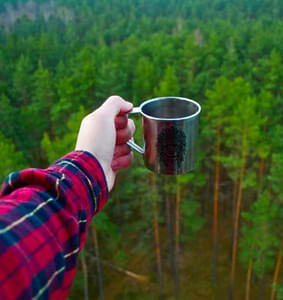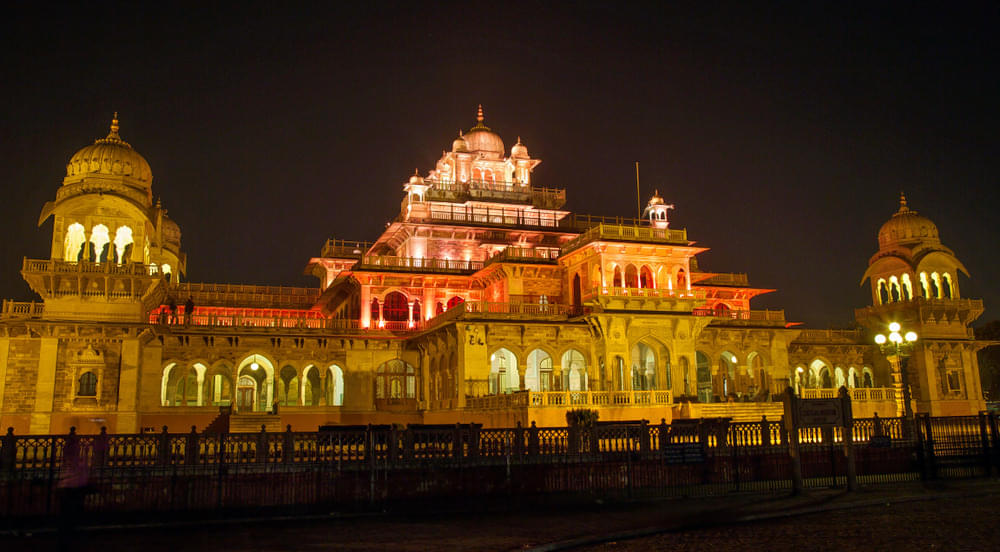About Albert Hall Museum
The museum lies within the Ram Niwas Garden, Jaipur, and the oldest one in the state of Rajasthan. Discover Rajasthan's cultural treasures at Albert Hall Museum on our Rajasthan trip packages.
Albert Hall Museum is located in Jaipur, tucked within the lush expanses of Ram Niwas Garden. This architectural marvel dates back to 1876 and is Rajasthan's oldest museum. It is influenced by the London-based Victoria & Albert Hall Museum. The museum is also a testament to Indo-Saracenic architecture. Here, you can see a rich blend of Victorian elements with Indian craftsmanship.
The museum's history is as fascinating as its collections. The museum was Initially built as a concert hall. It was then turned into a museum under the vision of Maharaja Sawai Madho Singh II. Today, the museum is home to a wide collection of artefacts that highlight Rajasthan's artistic and cultural heritage. By sunset, the museum transforms into a beautiful illuminated wonder. The twinkling lights also highlight the museum's architectural beauty.
Inside, the museum is a treasure trove of Rajasthan's history, art and culture. It has 16 galleries, each of which has exhibits related to metal, pottery, jewellery, textiles and more. From ancient coins and marble to an Egyptian mummy, the diversity is astounding. The museum also serves as a cultural bridge. It captivates history enthusiasts, offering a deep dive into the past. Additionally, it educates visitors on Rajasthan's and the world's rich cultural heritage.
History of Albert Hall Museum -
The foundation of the museum was set when Albert Edward, the Prince of Wales visited Jaipur in the year 1876.
There was no certainty as to how the museum would be used, and therefore, on the recommendation of Maharaja Sawai Madho Singh II, a temporary museum was constructed in 1881.
It then exhibited the works of art created by the local artisans. Swinton Jacob, an eminent architect of that time, completed the construction of Albert Hall in 1887. It was then that the artifacts from the temporary museum were moved to the newly built Albert Hall.
By the year 1890, the museum stood complete with the Mayo Hospital within a public park, thus embodying the vision of the earlier Maharaja Sawai Ram Singh.
His descendant Sawai Madho Singh realized the Maharaja’s dream, thus depicting a new Jaipur city progressing into the contemporary age.
The Architecture of Albert Hall Museum -
Albert Hall Museum resembled the splendid Indo- Saracenic architecture, the hallways or corridors adorned with murals of diverse styles. It resembled the history and culture of the Egyptian, European, Greek, Babylonian, and Chinese civilizations.
Albert Hall soon became the centre stage for teaching the history of different civilizations. The museum-inspired artisans to hone their artistic skills as well as preserve traditional art, architecture, and craft forms of India.
When it comes to the architecture of the museum, the Egyptian mummy is a feast to travelers’ eyes as well as history aficionados.
The architecture of Albert Hall is the fusion of elaborate Islamic architecture and Neo-gothic style. The unique architecture of the museum used by the British in India and implemented in most public and government buildings.
The decorative and stylish components of this museum are one of the classic examples of architectural elegance and finesse of that period. If you have a penchant for design and architecture; you will love Albert Hall’s elaborate carvings as well as the distinctive ‘Chatri’ style towers that resemble impeccable artistry.
Gallery of Albert Hall Museum -
One of the striking features of Albert Hall Museum is its galleries displaying works of art, treasures, and antiques belonging to the nineteenth century. The popular galleries are:
1. Clay Art Gallery
It houses beautiful, delicate clay models of nineteenth-century displaying sociological themes, different yogic postures, and art of craft making.
You will find a clay model depicting judicial execution of that time, a plaster-cast clay model of a female leg painted with geometrical designs in red, a saint in a yogic posture, and many more.
2. Carpet Gallery
Visit this gallery to feast your eyes. The Persian Garden Carpet is the superlative example of stunning Persian carpets around the world.
Bought during the times of Mirza Raja Jai Singh I, the rare carpet represents a scene from a Persian garden. The work of art has four parts and numerous sub-sections.
Each part has varied colors that make the carpet look stunning. Birds, fish, turtles, and other Chinese animals are depicted on this carpet.
The gallery also houses circular carpets as well as doormats representing flowery and Mughal patterns.
3. Jewelry Gallery
You can see most of the low-cost jewelry worn by the peasants of that time. Most of the ornaments were made of brass and silver.
The popular items of jewelry include rings, anklets, bracelets, necklaces, and hairpins.
4. Coin Gallery
If you have a passion for coins, you must visit this gallery. Take a tour of this place to see a huge variety of coins of the British and Mughal age. You will love the punch-marked coins, which are ancient in history.
You can see numerous coins of the times of Jahangir, Akbar, Aurangzeb, and Shah Jahan. These coins were discovered from different parts of Rajasthan. They were collected and preserved in the museum gallery.
5. Musical Instruments Gallery
You will find ancient Indian musical instruments in this gallery of Albert Hall. The popular instruments include Dhap, Shehnai, Masak Baja, Karana, Rabab, and Pungi Ravan Hatha to name a few.
6. Marble Art Gallery
You can see some of the best exhibits of the nineteenth-century sculptures designed by the artisans of Jaipur in the Marble Art Gallery of Albert Hall.
The popular works of art include Dasa Avatar and Mahisasur Mardini, Nav Grahas and Ganesh, Shiv Pariwar, Jain Tirthankars, Vaishnav and Brahma Parivar.
7. Pottery Gallery
Albert Hall houses some of the finest pottery collections of the nineteenth century, representing diverse range, intricacy, and vitality of the craft tradition of India.
The gallery houses a range of flower vases. The most prominent one is the white quartz clay vase showing the king and queen on either side with cobalt blue and copper designs. You will also love to see the Kagazi (water bottle) doubled-handled surahi featuring a triangular design on the rim.
8. Arms and Armour Gallery
The gallery houses Mughal, Rajput, Afghan, Arab, Turkish hilts, swords, helmets, tiger knives, spears, clubs, and shields, in silver and gold.
The popular collections include Arabian dagger, Qama or knife, Goad, gun powder horn, tiger claws, Gauntlet, and more.
Albert Hall Museum Highlights
• Discover the fusion of Indo-Saracenic architecture and European designs at Jaipur's oldest museum.
• Witness the museum transform as it lights up at night, making it a sight to behold.
• Explore the 16 galleries in the museum, which house ancient coins and even an Egyptian mummy.
• Head to the Clay Works Gallery, which has clay models depicting sociological themes.
• Marvel at the Persian Garden Carpet and admire Persian art in the Persian Gallery.
How To Reach Albert Hall Museum
By Road: The Albert Hall is located near Ajmeri Gate, in Ramniwas Bagh. It is around 2 kilometres from the city centre.
By Bus: Take a bus from the Narayan Singh Circle bus stop in the city centre to the Maharaja College bus stop. From here, the museum is 600 metres away, which you can cover in 5 minutes.
By Car: If driving, head towards MI Road and follow the signs to Albert Hall Museum. Parking is available near the museum. The drive from the city centre can take around 10-15 minutes.
Best Time To Visit Albert Hall Museum
Albert Hall Museum is a gem in Jaipur, inviting visitors year-round with its rich heritage.
Best Day: Weekdays ensure a less crowded experience, providing a peaceful exploration. You can have full access to all exhibits and explore the museum without the visitor rush.
Best Time of Day: Mornings are the perfect time to visit the museum. With fewer crowds around, you can take your time to see all the exhibits here. Additionally, visit during sunset to see the museum beautifully lit up.
Albert Hall Museum Other Essential Information
Facts about Albert Hall Museum-
1. The museum is also called the Government Central Museum and the oldest museum in Rajasthan. The museum was designed by Samuel Swinton Jacob, a British architect.
2. It’s been christened after King Albert Edward VII. You can see the perfect mix of Indo-Saracenic architecture when visiting the museum.
3. Initially, Albert Hall planned as a town hall but later, Madho Singh II designed it in the form of a museum. The museum is 133 years old.
4. Rudyard Kipling, a British journalist, poet, and short-story writer was so astounded by the aura, historical significance, and architecture of Albert Hall that he wrote, “It is now a rebuke to all other museums in India from Calcutta downwards.”
Tips for Visiting Albert Hall Museum -
- Do not carry plastic items inside the museum.
- Do not carry a camera and use your mobile phone to take photographs in the museum.
- Wear comfortable shoes to explore the museum without hassle.
- Carry a water bottle to stay hydrated during your museum exploration.
- Hire a guide to enrich your visit with detailed stories and historical insights.
- Set aside 1-2 hours to fully experience all that the museum offers.
Explore the Egyptian Mummy Exhibit
Witness the Egyptian Mummy, which is one of the major highlights of the museum. The Albert Hall Museum is one of the five museums in the country to house an original Egyptian mummy. It is housed in the Egyptian Gallery in the museum and dates back to 2,500 years in time. Here, you can learn about the process of mummification and other ancient Egyptian burial practices. This exhibit originally belonged to the banks of the Nile river, and offers you a window into the distant past, bringing a part of Egypt to Jaipur. It shows the advanced embalming methods of ancient Egyptians. These methods also highlight their strong belief in life after death.
Admire the Persian Garden Carpet
The Persian Garden Carpet in the museum's Persian Gallery is another popular masterpiece. It is an example of the detailed craftsmanship of Persian weavers. The carpet dates back to the 17th century and shows a garden scene which symbolises paradise. The vibrant colours and detailed design invite you to lose yourself in its beauty. The design also includes motifs of animals, flowers, and other symbols. These details provide insight into the Persian aesthetic and concepts of beauty, nature, and the divine. The gallery also offers a glimpse into the luxurious courts of Persia. The carpet, along with other exhibits, highlights the cultural exchange between the Mughals and Persians.
Discover the Coin Gallery
The Coin Gallery offers a fascinating journey of the evolution of currency. It boasts an impressive collection of coins from the Mughal and British eras. You can even come across punch-marked coins here, which are said to be the earliest coins ever used. Each coin tells a story of trade, conquest, and civilization. The gallery is a great spot for history buffs and curious minds alike. It provides a unique perspective on the socio-economic history of India and the world. The gallery highlights the artistry in coin minting with rare and ancient coins. These coins reveal the evolution of currency from barter systems to modern banking.
Be Enthralled by the Musical Instruments Gallery
Step into the Musical Instruments Gallery, where ancient Indian music comes to life. This collection features a variety of traditional instruments from the times gone by. Some of these include Sitar, Sarangi, Ektara, Dholak, Pakhavaj, Been, and Alghojha. The gallery's highlights also include the Rabab and the Shehnai. Each instrument here invites you to explore India's rich musical heritage. It highlights the importance of music in Indian society, from royal courts to religious ceremonies. These instruments also play a key role in preserving India's musical heritage.
Immerse in the Pottery Gallery
The Pottery Gallery showcases the incredible diversity and skill of Indian potters. As you explore the gallery, you can see utilitarian vessels to intricate artistic pieces. The wide range of pottery on display here reflects the rich cultural tapestry of India. Each piece has a unique glaze, shape, and design. Here, you can find works of burnished, lacquered, slip-painted, incised ware pottery. This offers insights into the evolution of pottery techniques over time. This gallery also helps you learn about the preservation of local traditions. It highlights the deep-rooted connection between pottery and Indian civilization.
Tourism Board Alliances
Albert Hall Museum FAQs
1. Who Built Albert Hall
Is camera allowed in Albert Hall?
Can I bring my own food and drink into the Hall?
When was Albert Hall Jaipur built?
Is there car parking at the Albert Hall?
Albert Hall Museum Reviews


























.jpg?w=1280&dpr=1)

.jpg?w=1280&dpr=1)







